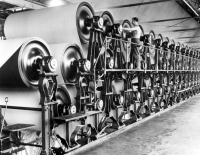








Fourdrinier machine, device for producing paper, paperboard, and other fibreboards, consisting of a moving endless belt of wire or plastic screen that receives a mixture of pulp and water and allows excess water to drain off, forming a continuous sheet for further drying by suction, pressure, and heat. Calenders (rollers or plates) smooth the paper or board and impart gloss or other desired finish to the surface. The first machine to produce a continuous web (roll), the Fourdrinier machine was invented in France in 1799 by Louis Robert and was subsequently improved in England, where it was patented by Henry and Sealy Fourdrinier.
History
Before the invention of continuous paper making, paper was made in individual sheets by stirring a container of pulp slurry and either pouring it into a fabric sieve called a sheet mould or dipping and lifting the sheet mould from the vat. While still on the fabric in the sheet mould the wet paper is pressed to remove excess water and then the sheet was lifted off to be hung over a rope or wooden rod to air dry. In 1799, Louis-Nicolas Robert of Essonnes, France, was granted a patent for a continuous paper making machine.At the time Robert was working for Saint-Léger Didot, with whom he quarrelled over the ownership of the invention. Didot thought that England was a better place to develop the machine. But during the troubled times of the French Revolution, he could not go there himself, so he sent his brother in law, John Gamble, an Englishman living in Paris. Through a chain of acquaintances, Gamble was introduced to the brothers Sealy and Henry Fourdrinier, stationers of London, who agreed to finance the project. Gamble was granted British patent 2487 on 20 October 1801.
With the help particularly of Bryan Donkin, a skilled and ingenious mechanic, an improved version of the Robert original was installed at Frogmore Mill, Apsley, Hertfordshire, in 1803, followed by another in 1804. A third machine was installed at the Fourdriniers' own mill at Two Waters. The Fourdriniers also bought a mill at St Neots intending to install two machines there and the process and machines continued to develop.
In the USA the first recorded paper machine was Gilpin's at Brandywine Creek, Delaware in 1817. This machine was also developed in England, but it was a cylinder mould machine. The Fourdrinier machine was introduced into the USA in 1827.
The method of continuous production demonstrated by the paper machine influenced the development of continuous rolling of iron and later steel and other continuous production processes.